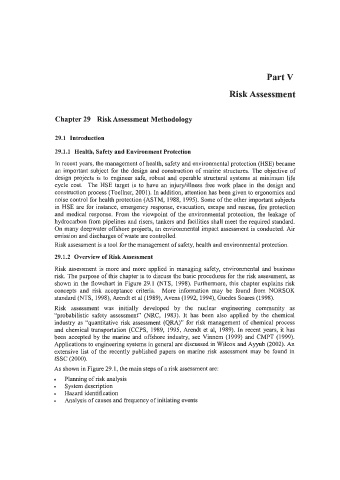Page 539 - Marine Structural Design
P. 539
Part V
Risk Assessment
Chapter 29 Risk Assessment Methodology
29.1 Introduction
29.1.1 Health, Safety and Environment Protection
In recent years, the management of health, safety and environmental protection (HSE) became
an important subject for the design and construction of marine structures. The objective of
design projects is to engineer safe, robust and operable structural systems at minimum life
cycle cost. The HSE target is to have an injuryhllness free work place in the design and
construction process (Toellner, 2001). In addition, attention has been given to ergonomics and
noise control for health protection (ASTM, 1988, 1995). Some of the other important subjects
in HSE are for instance, emergency response, evacuation, escape and rescue, fire protection
and medical response. From the viewpoint of the environmental protection, the leakage of
hydrocarbon &om pipelines and risers, tankers and facilities shall meet the required standard.
On many deepwater offshore projects, an environmental impact assessment is conducted. Air
emission and discharges of waste are controlled.
Risk assessment is a tool for the management of safety, health and environmental protection.
29.1.2 Overview of Risk Assessment
Risk assessment is more and more applied in managing safety, environmental and business
risk. The purpose of this chapter is to discuss the basic procedures for the risk assessment, as
shown in the flowchart in Figure 29.1 (NTS, 1998). Furthermore, this chapter explains risk
concepts and risk acceptance criteria. More information may be found from NORSOK
standard (NTS, 1998), Arendt et a1 (1989), Avens (1992,1994), Guedes Soares (1998).
Risk assessment was initially developed by the nuclear engineering community as
“probabilistic safety assessment” (NRC, 1983). It has been also applied by the chemical
industry as “quantitative risk assessment (QRA)” for risk management of chemical process
and chemical transportation (CCPS, 1989, 1995, Arendt et al, 1989). In recent years, it has
been accepted by the marine and offshore industry, see Vinnem (1999) and CMPT (1999).
Applications to engineering systems in general are discussed in Wilcox and Ayyub (2002). An
extensive list of the recently published papers on marine risk assessment may be found in
ISSC (2000).
As shown in Figure 29.1, the main steps of a risk assessment are:
Planning of risk analysis
System description

